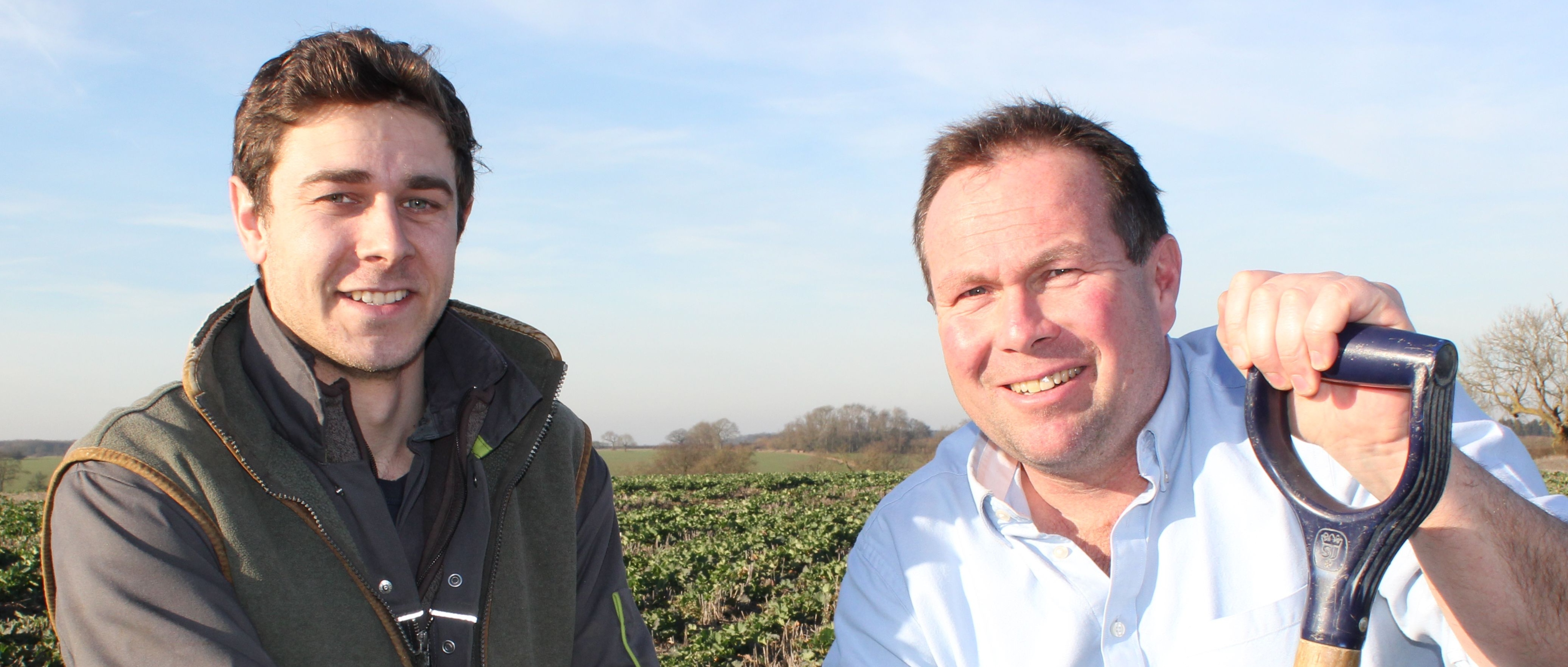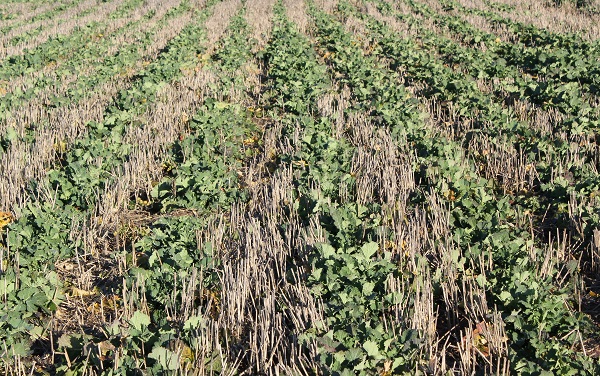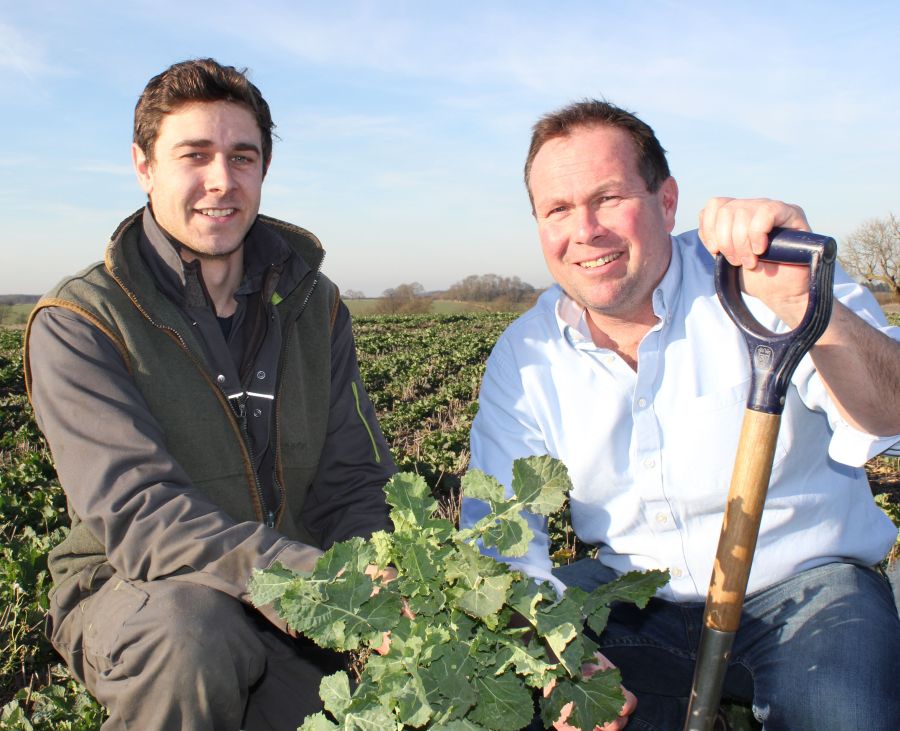
Year in, year out, oilseed rape performance at a consistently high level remains elusive for many. But, as CPM finds out from another two growers with quite different challenges, approaches and regimes, it’s perfectly achievable.
The crops were really nice and even with an excellent pod set.
By Rob Jones
Folkingham Farms near Sleaford in Lincs and the Kendall family on the Yorks Wolds just outside Market Weighton share five-year average oilseed rape yields on the right side of 4.5t/ha. Both know their crops can deliver 5t/ha or more in good seasons. Equally importantly, even where conditions are less favourable they average comfortably over 4t/ha to compete well with alternative cereal breaks.
Neither of the growers are content to rest on their laurels, however. Instead, both are keen to build consistent performance at the highest possible level through continual improvement. And they’re doing so by focussing their efforts on the management essentials they’ve found to matter most.
OSR growing isn’t getting any easier at Folkingham Farms near Sleaford in Lincs. But George and Clare Atkinson and their stepson, Oliver Fountaine are determined to keep on getting better at it. They set themselves a high target, take advantage of every opportunity to reach it and, above all, never give up on crops too quickly.
Despite increasing pressures from verticillium wilt and cabbage stem flea beetle, the crop remains a key part of the partnership’s 1500ha rotation. Margins are securely up there alongside 10.5t/ha first wheats. And the crop is particularly valued for its contribution to the blackgrass control that’s the driver behind all agronomic decisions.
“We’re very flexible rotationally these days to deal with blackgrass” George explains. “As well as wheat and OSR, we have winter and spring barley, winter beans, peas and sugar beet on our mainly heavy clay loam ground. We typically grow OSR every four or five years after either winter barley or wheat.”
At 4.2t/ha last season, the dry summer knocked back five-year average yields to 4.6t/ha. However, oils above 47% from the 530ha of mainly DK Expansion and DK Expedient certainly helped make up for this.
“The crops were really nice and even with an excellent pod set,” notes George. “They would have at least matched the 4.8t/ha we achieved three years in a row with our long-time favourite, DK Extrovert if it hadn’t been for the drought.
“Interestingly, our best OSR yield – at over 5t/ha – came from 40ha after peas as a double break on a bad blackgrass field. We grew the Clearfield variety, DK Imperial CL because we were nervous of SU residues from spring imazamox. It showed unbelievable vigour, suffered the least verticillium and delivered the best margin of all. It certainly seems to have something extra in the establishment department, especially after peas.
“The bulk of our current crop is DK Expansion and DK Expedient again and I’m not sure how we got most of it through the nightmare of establishment. Our soils came out of the summer dry and we had virtually no rain from the time we drilled in mid-Aug to the beginning of Oct. So the flea beetle, which we saw more of than ever, had a field day. We were lucky to lose only 25% of our plantings. Many round here wrote off far more. In fact, we were very close to doing so too. But we held on and they’ve come through the winter surprisingly well.”
Much of the reason for getting most of this season’s OSR through has to be the ‘mild obsession’ George and Oliver have with sowing behind ultra-low disturbance subsoiler legs built locally for them. Using a Sumo Trio with the discs out, they put 50-55 seeds/m² into 50cm bands. The legs work to only 225mm at 7km/h to leave a virtually undisturbed stubble surface.
This creates a good tilth around the seed while disturbing the least amount of blackgrass and preserving all-important soil moisture. A double press on the Sumo and a heavy set of Heva rolls working at a similarly steady speed close behind adds to moisture conservation and ensures the best possible seed-to-soil contact.
“We used to sow across the full width of the Sumo with the discs in,” recalls Ollie. “Apart from encouraging too much blackgrass growth in the seedbed, we found the plants growing behind the legs had twice the length of root. So now we only put seeds behind the legs.
“We spray off a decent flush of weed growth ahead of OSR drilling whenever we can. “Centurion Max (clethodim) gives us a good kill of any early emerging blackgrass and allows us to hold off on our propyzamide until the second half of Nov for the best activity against the second flush.”
Folkingham Farms are equally ‘fussy’ with OSR nutrition. They currently spin on 30kgN/ha as DAP after drilling. They gave up on liquid fertiliser with the seed in 2012 because the systems then available got in the way of their narrow establishment window. But they’re going back to band-applied liquid nitrogen and phosphate this year with an altogether higher capacity front linkage-mounted system.
“This gets more of the fertiliser where we want it,” George points out. “Something we’re equally keen to do in the spring. Over the years, we’ve learnt to be much braver with our nitrogen. Based firmly on Green Area Index, we drip feed it with the right balance of sulphur in our two first splits then finish off with straight N at yellow bud.
“We vary nitrogen rates – which are typically between 150-210kgN/ha – according to crop condition across the fields. We also apply phosphate and potash variably with the Omnia system and use biosolids and P-Grow in the rotation where needed to maintain phosphate levels.
“Benchmarking with other local growers highlights that we spend more on micro-nutrition than most, never going through the crop with the sprayer without including a foliar feed. “We’re currently using Brassitrel Pro in the autumn and at stem extension, with Maxiphi Hi-Mag for extra magnesium at both stem extension and flowering because our ground can lock it up badly.”
Wold confidence
Bringing in a remarkably consistent average of just over 4.5t/ha from OSR on their Wold land at Arras Farm near Market Weighton for the past five years, Chris and Wendy Kendall are confident they can push this to a good 5t/ha.
Not least because they have the help of both Agrii agronomist, Dave Clark who knows the local ground like the back of his hand and ADAS crop physiologist and Oilseed YEN co-ordinator, Dr Sarah Kendall who happens to be their daughter.
“Our DK Explicit yielded 6.1t/ha here in 2015,” points out Chris who manages the 190ha of cropping single-handed. “And in the two years the YEN competition has been running our entries of DK Exalte and DK Exclaim have averaged 4.7t/ha and 4.9t/ha respectively, providing us with a wealth of information on crop performance and possible avenues for improvement.

There’s a ‘mild obsession’ at Folkingham Farms with sowing behind ultra-low disturbance subsoiler legs into 50cm bands at 50-55 seeds/m².
“With vining peas, potatoes and spring barley in our wheat-based rotation, it helps that we never grow OSR more frequently than one year in every five. Equally, our silty clay loam over chalk provides a good reservoir of moisture.
“However, our cereals rarely come off before the end of Aug. We bale all the straw for our 40,000-bird duck-rearing unit and incorporate muck from it ahead of the OSR. So we can’t realistically drill until the middle of Sept.”
Sowing considerably later than most presents a particular challenge. Especially so, with the Wolds micro-climate and number of north-facing slopes. So the Kendalls have to be right first time with their establishment.
Their regime involves incorporating the muck with a Lemken Terradisc, setting up the seedbed with a Challenger Agri Phoenix and drilling in 30cm rows with a Horsch Pronto, all within the space of a few days. This provides the right degree of tilth, moisture preservation, sowing depth control and seedbed quality for all-important pre-emergence herbicide activity.
Using the most vigorous varieties available and following the drill with a single rolling, targeted slug pelleting and 30kgN/ha on the seedbed, this ensures reliably robust establishment even in the face of long-standing local flea beetle issues.
“DK Exclaim is currently our first-choice variety,” Dave explains. “It has the same early get-up-and-go as the DK Explicit and DK Exalte we’ve grown previously. But we particularly like the fact it doesn’t take off too early in the spring. The ground here takes a while to warm up so we want the crop to grow away rapidly only once the soil allows it to access the nutrition it needs. We also appreciate the variety’s relatively open canopy structure.
“Later drilling generally helps in our fight against flea beetle,” notes Dave, “especially with larvae levels. We needed a fairly intense programme of lamba-cyhalothrin with Biscaya (thiacloprid) to weather last autumn’s storm. But we’ve come out of the winter with a healthy, even stand of 36 plants/m², so we’ve obviously done something right.”
Effective early weed control is a key part of the OSR recipe at Arras Farm, with a pre-em mixture of napropamide and clomazone followed with Katamaran Turbo (dimethenamid-p+ metazachlor+ quinmerac) as soon as the crop is up. An early graminicide is employed to take out the first flush of cereal volunteers, with Kerb (propyzamide) in Nov dealing with any late-emerging volunteers and wild oats.
With blackgrass problems kept well in check by the rotation and Chris Kendall’s religious rogueing, only a low propyzamide rate is required. This is combined with half-rate Kestrel (prothioconazole + tebuconazole) which is quite sufficient to tidy up any phoma – thanks to robust varietal resistance – and keep well ahead of light leaf spot.
Later drilling also makes LLS control very much easier, Chris and Dave note, completing their foliar disease management programme with Kestrel at stem extension.
With early spring GAIs invariably well below 1.5, plant growth regulation isn’t on the agenda. Instead, their spring canopy management strategy is very much nitrogen-focussed. Around 240kgN/ha is applied overall, half going on as early as possible and the remainder divided between stem extension and early flowering. A balanced N:S liquid mix throughout also supplies 75-80kg/ha of SO3.
Soil pHs of over 8.0 mean foliar nutrition is essential to get around nutrient-availability issues, says Dave. “And the ground is traditionally low in magnesium. So we routinely add both Mg and boron in the late autumn, at stem extension and with our sclerotinia spray.
“Preliminary conclusions from YEN suggest higher yields are associated with higher soil Mg levels than we see here,” Sarah notes. “The YEN reports also indicate our seed Mg levels are on the low side. So we may well benefit from upping the foliar Mg still further. After all, the quantities needed to support chlorophyll production make it very much a major plant nutrient not a micro-nutrient.”
In addition to extra Mg, a range of other agronomic improvements are being considered from the Kendalls’ own experience and intelligence gleaned from the YEN competition. These include adding fresh available P to the seedbed to encourage greater rooting, and later nitrogen and/or a strobilurin at late flowering to extend canopy life.
“We saw some interesting yield benefits from the few tweaks we made to our 3.8ha YEN tramlines last season compared with the rest of the field,” adds Sarah. “Encouragingly too, we achieved 41% of the theoretical yield for the site in 2018 against 36% in 2017. But with very similar YEN performances built very differently over the two years, we’ve plenty of work to do to make sure we focus on the most fruitful areas for improvement.”
OSR Improvement
In this latest series, Dekalb is once again working with CPM to share the widest possible experience of growers and their agronomists across the country in improving winter oilseed rape performance.
This is part of Dekalb’s role in providing trusted support to OSR growers and their agronomists that goes well beyond the most robust and dependable varieties that have always been the company’s trademark.
We very much hope you’ll find this series valuable in fine-tuning your OSR improvement efforts to secure the most consistent returns from the crop both financially and rotationally.




